/home/virtual/kjpt/journal//../xmls/kjpt-53-3-213.xml
JO, JANG, JEONG, KIM, and CHUNG: Comparative morphological analysis reveals a new record of Boehmeria nakashimae (Urticaceae) in Korea
Abstract
A newly recorded species, Boehmeria nakashimae Yahara, is confirmed for the first time to be distributed on forest edges on Jejudo Island, Korea. This species is known to be endemic to northern Kyushu, Japan. It is characterized by ovate to broadly ovate, elliptic-ovate, or sub-orbicular middle leaf shapes, serrulate-dentate and uniform margins, 17–29 teeth on one side, a short caudate or narrowly acute apex, dense glomerules at fruiting, and densely strigillose on the stems, both surfaces of the leaves, the perianth of staminate flowers, and achenes. Therefore, it is given the new name ‘Je-ju-top-mo-si-pul’ in Korean based on its serrulate-dentate leaf margin and geographical distribution. A description, photographs, illustrations, and keys of related taxa in Korea are provided.
Keywords: Boehmeria nakashimae, Korea, newly recorded species, Urticaceae
INTRODUCTION
The genus Boehmeria Jacq. (Urticaceae) comprises approximately 100–150 species and is widely distributed across tropical and subtropical regions ( Wang, 1981a; Yahara, 1981; Chen et al., 2003; Wilmot-Dear and Friis, 2013). The genus is distinguished from related genera by plants without stinging trichome, inflorescence without involucre, staminate flowers with 3–5 stamens, inflexed filaments, pistillate flowers with tubular perianth, filiform stigma, remaining perianth of the achene, etc. ( Chen et al., 2003; Kim and Sun, 2018). Based on morphological characteristics, including phyllotaxis, leaf margin shape, achene shape, and trichome, Satake (1936) recognized two subgenera and seven sections. Later, Wang ( 1981a, 1981b, 2016) degraded these to section or series rank by habit, leaf apex shape, inflorescence shape, and achene shape, and treated five sections. Although the morphological characteristics of the leaves are highly variable, the shape, margin, trichome, and texture of leaves are known to be important characters in the current classification systems ( Satake, 1936; Wang, 2016; Jo, 2023). Approximately 12–14 taxa of Boehmeria are known to be distributed in Korea ( Kim and Sun, 2018; Korea National Arboretum, 2023). Recently, Jo et al. (2021) recognized two unrecorded species, B. gracilis C. H. Wright and B. silvestrii (Pamp.) W. T. Wang. In the Korean Boehmeria, B. hirtella Satake, B. nakaiana Satake, B. quelpaertensis Satake, and B. taquetii Nakai have been considered as endemic species in Jejudo Island, Korea ( Lee, 1996). However, Jo (2023) recently treated B. nakaiana and B. taquetii as newly additional synonyms of B. sieboldiana Blume, and B. hirtella and B. quelpaertensis were also confirmed to be distributed in Japan. Therefore, he did not consider these two species as Korean endemic species. In conclusion, Korean Boehmeria was classified into a total of 13 species within two sections: sect. Tilocnide and Duretia, and three series: ser. Longispicae, Sieboldianae, and Spicatae in sect. Duretia ( Jo, 2023). While studying the genus Boehmeria collected in South Korea, we firstly confirmed the identity of B. nakashimae Yahara, which is known as an endemic species in Japan, on Jejudo Island. This species is distributed along the coast of northern Kyushu in Japan ( Yahara, 1983a, 1983b). It was first recognized as a hybrid of B. hirtella and B. holosericea Blume ( Yahara, 1983a). Yahara (1983a, 1983b) distinguished B. holosericea by leaves with a serrulate margin, a subcaudate-acuminate apex, and sterile staminate flowers. Unlike B. hirtella, B. nakashimae has large, thick leaves and dense trichomes on the stem, petiole, and leaf veins. Yahara (1983a) recognized as a triploid taxon reproducing by apomixis. Therefore, B. nakashimae is treated as a species rather than as a hybrid. In this study, we used scientific names and Korean names of Boehmeria based on the recently updated Checklist of Vascular Plants in Korea ( Korea National Arboretum, 2023). These scientific names had no nomenclatural problems, and this study focused on taxa with confirmed identities. We morphologically compared two closely related series, ser. Sieboldianae (including B. nakashimae) and ser. Longispicae, and have presented a key for taxa within these two series. Furthermore, descriptions, photographs, and illustrations of B. nakashimae are provided.
TAXONOMIC TREATMENT
Boehmeria nakashimae Yahara, J. Jap. Bot. 58: 88, 1983 ( Figs. 1, 2).—TYPE: Japan. Kyushu, Fukuoka Pref., Fukuoka City, Shikanoshima, 19 Sep 1937, K. Nakashima 15-a (holotype: TI!, barcode TI00082084; isotypes: “ Nakashima 15-b,” TI!, barcode TI00082085, “ Nakashima 15-c,” TI, not seen) ( Fig. 3).
Korean name: Je-ju-top-mo-si-pul (제주톱모시풀).
Herbs perennial, monoecious or dioecious. Stems lignified at fruiting, erect to descending, deeply sulcate, 1.2–2.0 m tall, 3.2–6.2 mm in diam., yellow-green, densely strigillose; piths not hollow. Leaves opposite, pairs subequal in size; stipules interpetiolar, free, reflex, caducous, lanceolate, 13.3– 15.2 × 4.5–5.9 mm, yellow-green, sparsely strigillose on the adaxial surface, sparsely strigillose on the abaxial surface, densely strigillose on the vein; petioles 6.1–14.0 cm long, 1.7–2.7 mm in diam., yellow-green, densely strigillose; middle leaf blades ovate to broadly ovate, elliptic-ovate, or sub-orbicular, 19.6–27.0 × 11.3–25.5 cm, base rounded, broadly cuneate, or cordate, margin serrulate-dentate, uniform, teeth 17–29 on one side, apex unlobed, short caudate or narrowly acute, adaxial surface green or yellow-green, densely strigillose, densely punctiform lithocysts with cystoliths, midvein flat, abaxial surface yellow-green, densely strigillose along midvein, densely hirsutulous along veinlets, chartaceous. Inflorescences axillary, spicate with glomerules; staminate inflorescences branched on middle part of stem, 10.3–14.9 cm long; pistillate inflorescences often branched or unbranched on upper half part of stem, 10.7–19.8 cm long, glomerules dense at flowering. Flowers unisexual; staminate flowers 4-merous, 4.4–5.9 mm wide; pedicels 0.3–0.6 mm long, yellow-green; perianth lobes cleft near to the middle, convex, elliptic, 1.1–1.4 × 0.8–1.1 mm, without appendages, yellow-green, strigillose in outside; filaments linear, inflexed, 1.6–2.5 mm long, yellow-green, anthers basifixed, 0.7–0.9 × 0.6–0.9 mm, white; ovary rudimentary, clavate; pistillate flowers 2.2–3.3 mm long, sessile; perianth tubes rhomboid to obovoid, 1.0–1.5 × 0.5–1.1 mm, yellow-green, strigillose; necks 2-lobed; style 1, linear, plumose, 1.2–1.9 mm long, white, stigma linear. Infructescences glomerules dense at fruiting, 3.8–5.4 mm wide. Achenes 32–119 per glomerule, rhomboid to obovoid to sub-orbicular, winged, 1.9–2.3 × 1.0– 1.4 mm, base cuneate or obtuse, strigillose.
Phenology: Flowering July to September, Fruiting September to November.
Distribution: Korea (Jejudo Island), Japan (Northern Kyushu and Shikoku) ( Fig. 4).
Habitat: This species inhabits half-shaded mesic places along forest edges near seashores ( Tateishi, 2006). It is also found at 200–900 m in Oreums and along roadsides on Jejudo Island.
Additional specimen examined: JAPAN. Shikoku: Kouchi Pref., Awa Susaki City, Awa-kaigan, 8 Nov 2012, T. Miyazaki 1211201 (PE); Kouchi Pref., Ootuki Town, Between Tomaru-ura and Tachibana-ura, 7 Oct 2003, T. Miyazaki 310152 (L).
KOREA. Jeju-do: Jeju-si, Aewol-eup, Bongseong-ri, Handae Oreum, 21 Oct 2021, H. J. Jo et al. HJ211021-002, 003 (ANH); Hallim-eup, Hyeopjae-ri, Biyangdo Island, 26 Jul 2022, H. J. Jo et al. HJ220726-002–004 (ANH); Hallim-eup, Mundoji Oreum, 19 Sep 2019, H. J. Jo et al. HJ190919-001 (ANH); 16 Jun 2021, H. J. Jo et al. HJ210616-001–003 (ANH); Jocheon-eup, Banong Oreum, 29 Jul 2021, H. J. Jo et al. HJ210729-001 (ANH); Seogwipo-si, Hawon-dong, 15 Sep 2020, H. J. Jo et al. HJ200915-003–005 (ANH); Sallongnam-ro, 1115, 20 Aug 2020, H. J. Jo et al. 200820-007 (ANH), 24 Aug 2022, H. J. Jo et al. HJ220824-004 (ANH).
Taxonomic note: At the habitats of B. nakashimae investigated in this study, B. holosericea and B. hirtella, which were previously recognized as parent species ( Yahara, 1983b), were not found. Especially, B. holosericea is geographically isolated from B. nakashimae and is only found along the coast. Boehmeria nakashimae is most similar to B. holosericea in terms of the middle leaf shape. However, the two species differ in morphological characteristics such as leaf margin, appendages of staminate flowers, and achene trichomes ( Table 1, Figs. 1, 2, 5). Boehmeria nakashimae is also distinctly distinguished from its related species, B. hirtella and B. sieboldiana, by morphological characteristics such as a deeply sulcate stem, a more densely strigillose stem, and a strigillose perianth of staminate flowers ( Table 1, Figs. 1, 2, 5).
Wilmot-Dear and Friis (2013) mentioned that B. nakashimae could be an intermediate form between B. holosericea and B. japonica (L. f.) Miq. However, in this study, we confirmed that this species reproduces through apomixis. Yahara (1983a) also recognized it as a triploid species reproducing by apomixis. In addition, this species is clearly distinguished from B. japonica and B. platanifolia (Maxim.) C. H. Wright by its plant trichomes, leaf margin shape, leaf apex shape, and achene trichomes ( Table 1, Figs. 1, 2, 5). Therefore, the new Korean name, ‘Je-ju-top-mo-si-pul’ was given based on its serrulatedentate leaf margin and geographical distribution in Korea.
Key to the Species of Boehmeria in Korea related to B. nakashimae
1. Staminate flower perianths appendaged; achenes hirsute, hirsutulous, or sericeous (Ser. Longispicae) 왜모시풀열
1. Staminate flower perianths without appendages; achenes strigillose (Ser. Sieboldianae) 긴잎모시풀열
5. Stems densely strigillose; middle leaf blades ovate or broadly ovate; abaxial surfaces densely hirsutulous on the veinlets
6. Stems shallowly sulcate, densely strigillose; staminate flower perianths hirsutulous ··················· ········································ B. hirtella 털긴잎모시풀 6. Stems deeply sulcate, more densely strigillose; staminate flower perianths strigillose ····················· ································ B. nakashimae 제주톱모시풀
5. Stems sparsely strigillose or sub-glabrous; middle leaf blades often rhombic-ovate; abaxial surfaces sparsely strigillose or sub-glabrous on the veinlets ·················· ·········································· B. sieboldiana 긴잎모시풀
ACKNOWLEDGMENTS
We thank Hiroshi Ikeda, Tokyo University for providing the type specimens. This study was carried out with support from the National Institute of Biological Resources (NIBR), funded by the Ministry of Environment (MOE) of the Republic of Korea (NIBR202107101), and with additional support from the ‘R&D Program for Forest Science Technology (2021400D10-2225DCA02)’ provided by the Korea Forest Service (Korea Forestry Promotion Institute).
Fig. 1.
Photographs of Boehmeria nakashimae. A. Habit. B. Underground structure. C. Base stem. D. Middle stem. E. Adaxial surface of stipule. F. Abaxial surface of stipule. G. Middle leaf. H. Adaxial surface of leaf. I. Abaxial surface of leaf. J. Staminate inflorescence. K. Bud of staminate flower. L. Staminate flower. M, N. Pistillate inflorescence. O. Pistillate flower. P. Infructescence. Q, R. Achene. 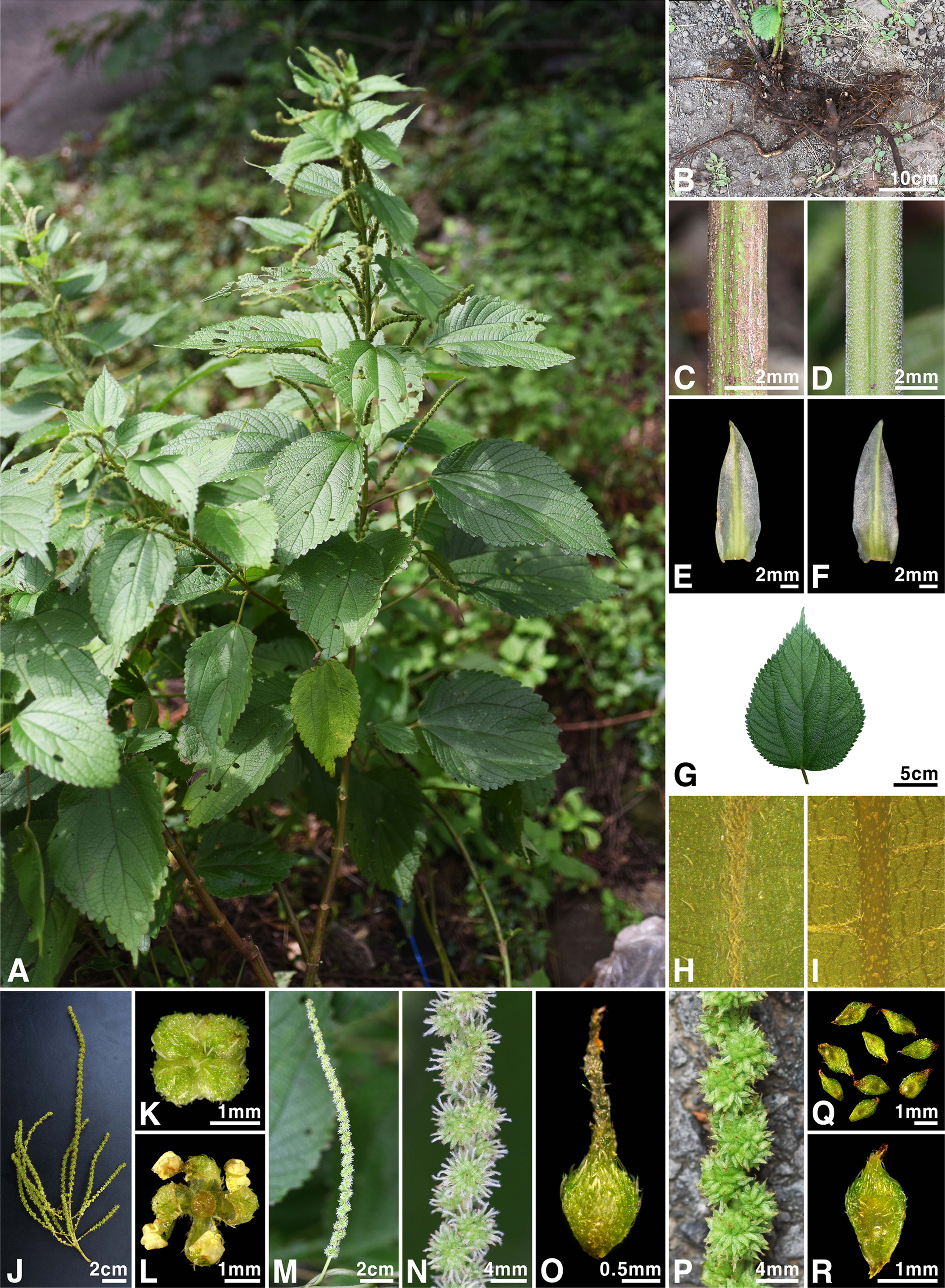
Fig. 2.
Illustrations of Boehmeria nakashimae. A. Plant. B. Leaf. C. Stipule. C. Bud of staminate flower. E. Infructescence. F. Achene. 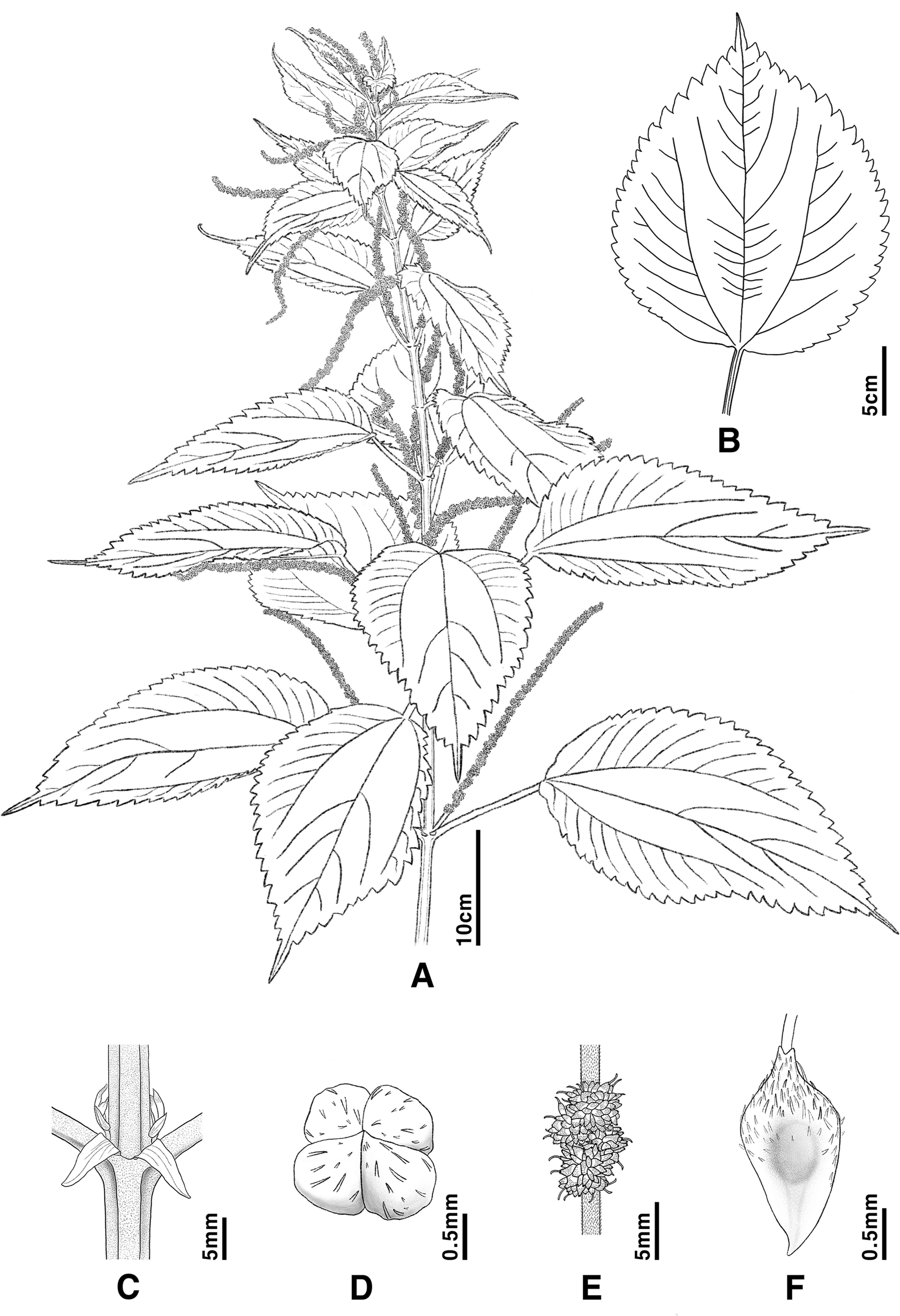
Fig. 3.
Type specimens of Boehmeria nakashimae. A. K. Nakashima 15-a (barcode TI00082084). B. 15-b (barcode TI00082085). 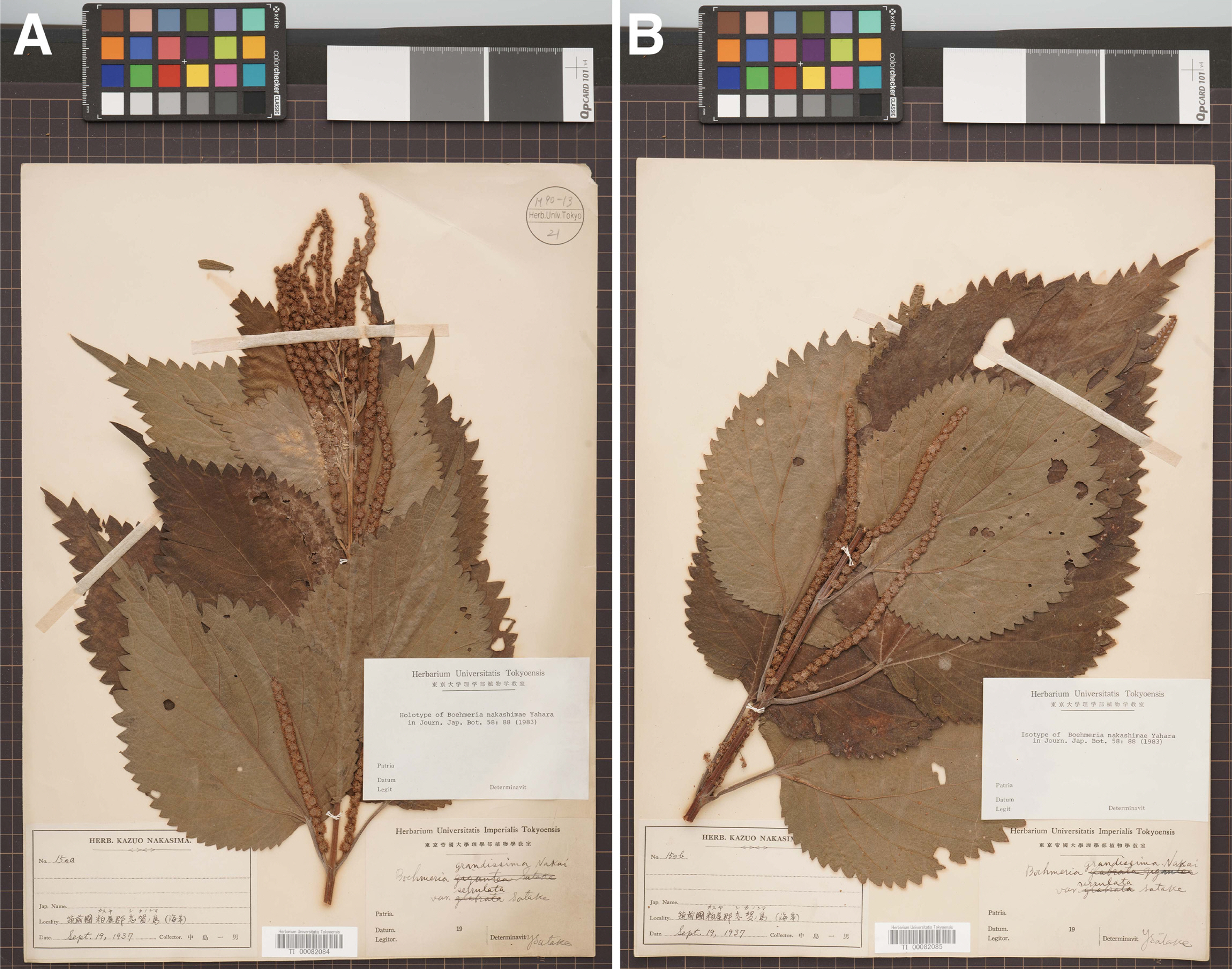
Fig. 4.
Distribution map of Boehmeria nakashimae. The star indicates the new location in Korea, and the circle indicates the existing location in Japan. 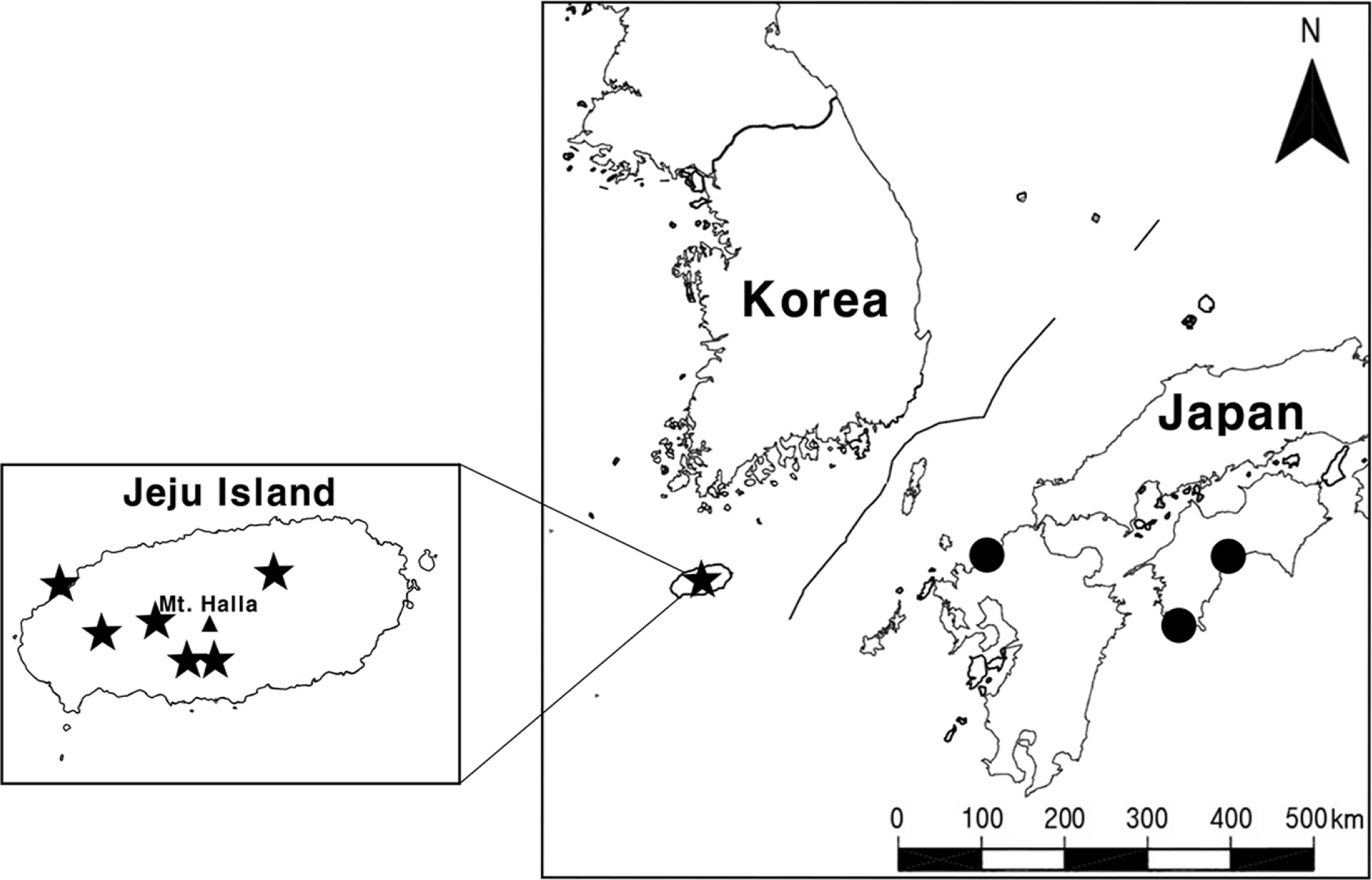
Fig. 5.
Photographs of morphological characteristics among Boehmeria nakashimae and its related taxa. A. B. holosericea. B. B. japonica. C. B. platanifolia. D. B. quelpaertensis. E. B. hirtella. F. B. nakashimae. G. B. sieboldiana. a, Stem; b, Leaf; c, Abaxial surface of leaf; d, Bud of staminate flower; e, Infructescence; f, Achene. 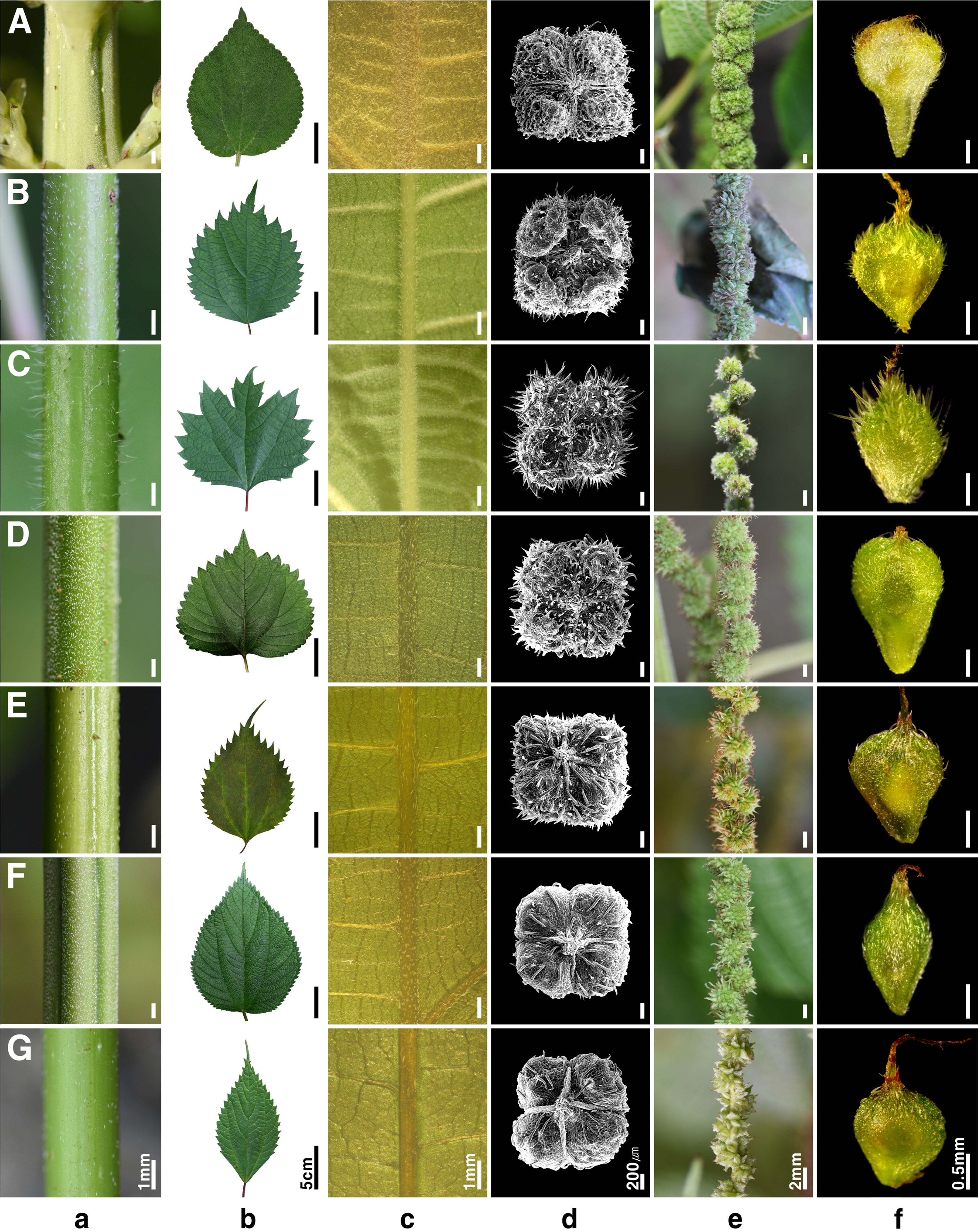
Table 1.
Comparison of morphological characteristics among Boehmeria nakashimae and its related taxa.
|
Taxa |
Stem |
Middle leaf blade |
|
|
Trichome |
Shape |
Lengtha (cm) |
Widtha (cm) |
Margin |
No. of teeth on each sidea
|
Arrangement of teeth |
|
Ser. Longispicae
|
|
|
|
|
|
|
|
|
B. holosericea
|
Densely assurgent hirsutulous |
Broadly ovate to orbicular-ovate |
15.1 (16.7) 18.9 |
13.0 (14.1) 16.0 |
Crenulate to serrulate-crenulate |
26 (31) 40 |
Uniform |
|
B. japonica
|
Densely assurgent hirsutulous |
Ovate, broadly ovate, broadly depressed ovate, or orbicular-ovate |
10.1 (17.8) 35.8 |
7.5 (13.7) 30.5 |
Serrate-dentate or serrate-bidentate |
9 (13) 18 |
Gradually larger distally |
|
B. platanifolia
|
Densely assurgent hirsute or hirsutulous |
Oblate to 5-angled broadly ovate, depressed orbicular-ovate, transversely oblong, broadly ovate, or broadly depressed ovate |
12.3 (21.3) 31.4 |
14.4 (20.8) 30.2 |
Serrate-bidentate, incised in apex |
5 (10) 17 |
Gradually larger distally |
|
B. quelpaertensis
|
Densely assurgent hirsutulous |
Broadly depressed ovate, broadly ovate, orbicular-ovate, sub-orbicular, or broadly deltate-ovate |
16.5 (22.1) 28.3 |
16.6 (22.4) 30.5 |
Serrate-dentate |
14 (19) 26 |
Gradually larger distally |
|
Ser. Sieboldianae
|
|
|
|
|
|
|
|
|
B. hirtella
|
Densely strigillose |
Ovate or broadly ovate |
12.6 (17.5) 22.2 |
7.9 (11.1) 15.4 |
Serrate or serrulate-dentate |
13 (18) 20 |
Uniform to gradually larger distally |
|
B. nakashimae
|
Densely strigillose |
Ovate to broadly ovate, elliptic-ovate, or sub-orbicular |
19.6 (23.1) 27.0 |
11.3 (16.3) 25.5 |
Serrulate-dentate |
17 (23) 29 |
Uniform |
|
B. sieboldiana
|
Sparsely strigillose or sub-glabrous |
Rhombic-ovate, elliptic-ovate, or rhombic-lanceolate to lanceolate-ovate |
8.0 (15.5) 25.6 |
3.8 (6.7) 12.8 |
Serrulate-dentate |
8 (16) 26 |
Uniform |
Table 1.
|
Taxa |
Middle leaf blade |
Perianth of staminate flower |
Infructescence |
Achene |
|
|
Lobe of apex |
Apex |
Abaxial surface |
Texture |
Appendage |
Trichome |
Glomerules |
Trichome |
|
Ser. Longispicae
|
|
|
|
|
|
|
|
|
|
B. holosericea
|
Unlobed |
Acute |
Densely velvety sericeous |
Thick chartaceous |
Present |
Sericeous |
Dense |
Sericeous |
|
B. japonica
|
Often unlobed, rarely 3- or 5-lobed |
Acuminate, caudate, or acute |
Densely hirsutulous |
Chartaceous |
Present |
Hirsutulous |
Dense |
Hirsutulous |
|
B. platanifolia
|
3- or 5-lobed |
Acuminate, acute, or caudate |
Densely hirsutulous |
Chartaceous or thin membranous |
Present |
Hirsute |
Loose |
Hirsute |
|
B. quelpaertensis
|
Unlobed |
Acute or narrowly acute |
Densely hirsutulous |
Thick chartaceous, chartaceous, or thin membranous |
Present |
Hirsutulous |
Dense |
Hirsutulous |
|
Ser. Sieboldianae
|
|
|
|
|
|
|
|
|
|
B. hirtella
|
Unlobed |
Caudate or acuminate |
Densely hirsutulous |
Often chartaceous or thin membranous |
Absent |
Hirsutulous |
Loose |
Strigillose |
|
B. nakashimae
|
Unlobed |
Short caudate or narrowly acute |
Densely hirsutulous |
Chartaceous |
Absent |
Strigillose |
Dense |
Strigillose |
|
B. sieboldiana
|
Unlobed |
Caudate |
Sparsely strigillose or sub-glabrous |
Often chartaceous or thin membranous |
Absent |
Strigillose |
Loose |
Strigillose |
LITERATURE CITED
Chen, C. J. Lin, Q. Friis, I. Wilmot-Dear, C. M and Monro, A. K. 2003. Urticaceae Juss. Flora of China, Vol, 5. Ulmaceae through Basellaceae. Wu, Z. Y. Raven, P. H (eds.), Science Press, Beijing and Missouri Botanical Garden Press, St. Louis, MO. 76-189.
Jo, H. J. 2023. A taxonomic study of the genus Boehmeria (Urticaceae) in Korea. PhD dissertation. Andong National University, Andong, Korea. 232 pp.
Jo, H. J. Kim, J. Y. Lee, Y. Park, S. H. Kwon, M. J. Jeong, S and Chung, G. Y. 2021. A taxonomic revision of the Boehmeria spicata complex (Urticaceae) in Korea. Korean Journal of Plant Taxonomy 51: 115-132.   Kim, C. H and Sun, B. Y. 2018. Urticaceae Juss. The Genera of Vascular Plants of Korea. Flora of Korea Editorial Committee (ed.), Hongreung Publishing Co., Seoul. 332-345.
Korea National Arboretum. 2023. Checklist of Vascular Plants in Korea. Published on the Internet. Retrieved Sep. 13, 2023, available from http://www.nature.go.kr. Lee, W. T. 1996. Lineamenta Florae Koreae. Academy Publishing Co., Seoul. 196-200 (in Korean).
Satake, Y. 1936.
Boehmeria japonica. Journal of the Faculty of Science, University of Tokyo, Section 3, Botany 4: 467-542.
Tateishi, Y. 2006. Urticaceae Juss. Flora of Japan, Vol. IIa. Angiospermae, Dicotyledoneae, Archichlamydeae. Iwatsuki, K. Boufford, D. E. Ohba, H (eds.), Kodansha, Tokyo. 101-108.
Wang, W.T. 1981a. Revisio Boehmeriae Sinicae. Acta Botanica Yunnanica 3: 307-328.
Wang, W.T. 1981b. Revisio Boehmeriae Sinicae (cont.). Acta Botanica Yunnanica 3: 401-416.
Wang, W.T. 2016. A revision of Boehmeria sect. Duretia ser. Spicatae (Urticaceae) of China. Bulletin of Botanical Research 36: 805-814.
Wilmot-Dear, C.M and Friis, I. 2013. The Old World species of Boehmeria (Urticaceae, tribus Boehmerieae): A taxonomic revision. Blumea 58: 85-216.  Yahara, T. 1981. Taxonomic studies of the Urticaceae 1. The genus Boehmeria in Thailand. Acta Phytotaxonomica et Geobotanica 32: 1-21.
Yahara, T. 1983a. A biosystematics study of the local populations of some species of the genus Boehmeria with special reference to apomixis. Journal of the Faculty of Science, University of Tokyo, Section 3, Botany 13: 217-261.
Yahara, T. 1983b. A recognition of Boehmeria nakashimae, sp. nov. (Urticaceae). The Journal of Japanese Botany 58: 82-89.
|
|
















